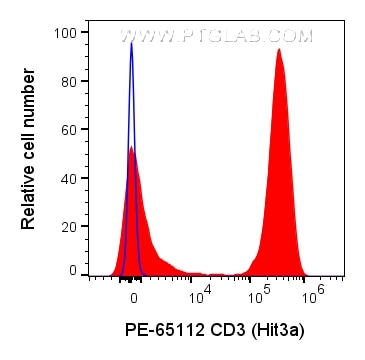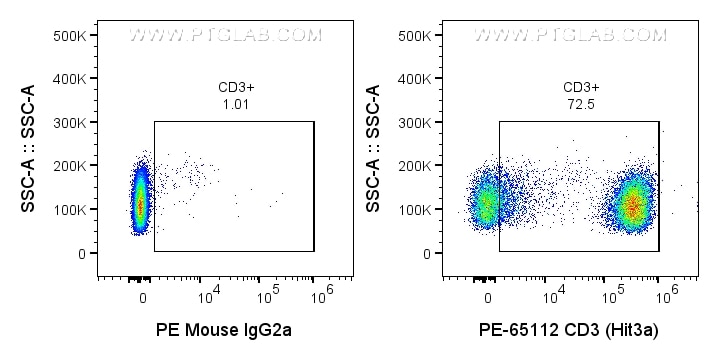Anticorps Monoclonal anti-CD3
CD3 Monoclonal Antibody for FC
Hôte / Isotype
Mouse / IgG2a, kappa
Réactivité testée
Humain
Applications
FC
Conjugaison
PE Fluorescent Dye
CloneNo.
Hit3a
N° de cat : PE-65112
Synonymes
Galerie de données de validation
Applications testées
| Résultats positifs en cytométrie | CMSP humaines, |
Dilution recommandée
| Application | Dilution |
|---|---|
| This reagent has been pre-titrated and tested for flow cytometric analysis. The suggested use of this reagent is 5 μl per 10^6 cells in a 100 µl suspension or 5 μl per 100 µl of whole blood. | |
| Sample-dependent, check data in validation data gallery | |
Informations sur le produit
PE-65112 cible CD3 dans les applications de FC et montre une réactivité avec des échantillons Humain
| Réactivité | Humain |
| Hôte / Isotype | Mouse / IgG2a, kappa |
| Clonalité | Monoclonal |
| Type | Anticorps |
| Immunogène | s/o |
| Nom complet | CD3e molecule, epsilon (CD3-TCR complex) |
| Masse moléculaire calculée | 207 aa, 23 kDa |
| Numéro d’acquisition GenBank | BC049847 |
| Symbole du gène | CD3 |
| Identification du gène (NCBI) | 916 |
| Conjugaison | PE Fluorescent Dye |
| Excitation/Emission maxima wavelengths | 496 nm, 565 nm / 578 nm |
| Forme | Liquide |
| Méthode de purification | Purification par affinité |
| Tampon de stockage | PBS with 0.09% sodium azide and 0.5% BSA |
| Conditions de stockage | Store at 2-8°C. Avoid exposure to light. Stable for one year after shipment. |
Informations générales
CD3 is a multimeric protein associated with the T-cell receptor (TCR) to form a complex involved in antigen recognition and signal transduction (PMID: 15885124). CD3 is composed of CD3γ, δ, ε, and ζ chains (PMID: 1826255). It is expressed by thymocytes in a developmentally regulated manner, T cells, and some NK cells (PMID: 3289580). The TCR recognizes antigens bound to major histocompatibility complex (MHC) molecules. TCR-mediated peptide-MHC recognition is transmitted to the CD3 complex, leading to the intracellular signal transduction (PMID: 11985657).
Protocole
| Product Specific Protocols | |
|---|---|
| FC protocol for PE CD3 antibody PE-65112 | Download protocol |
| Standard Protocols | |
|---|---|
| Click here to view our Standard Protocols |



